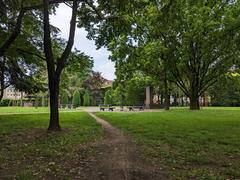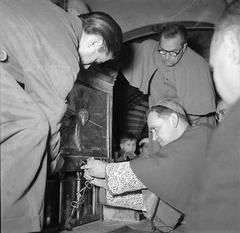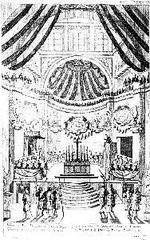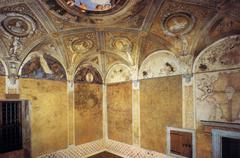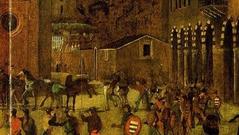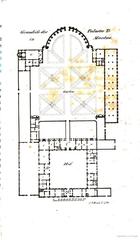
Palazzina della Paleologa: Visiting Hours, Tickets, and Guide to Mantua’s Historic Sites
Date: 04/07/2025
Introduction: The Palazzina della Paleologa in Mantua
Nestled in the heart of Mantua, Italy, the Palazzina della Paleologa symbolized the city’s Renaissance splendor and the sophistication of the Gonzaga court. Originally constructed in the early 16th century as a private residence for Margherita Paleologa, duchess consort of Mantua, this architectural jewel was designed by Giulio Romano. Although the palazzina was demolished in 1899, its artistic legacy continues through preserved frescoes and historical records, offering visitors a window into Mantua’s rich cultural and political history.
While the original structure no longer stands, its spirit endures in the frescoed camerini now housed within the Castello di San Giorgio—part of the grand Palazzo Ducale complex. Visitors to Mantua can explore these rooms, the broader Ducal Palace, and other Renaissance landmarks, immersing themselves in the city’s UNESCO-listed heritage (UNESCO). This comprehensive guide will outline the palazzina’s history, current visiting options, ticketing, accessibility, nearby attractions, travel tips, and resources for planning your visit.
Table of Contents
- Historical Overview
- Visiting Information
- Nearby Attractions and Travel Tips
- Frequently Asked Questions (FAQ)
- Visual Resources and Virtual Tours
- Summary and Further Exploration
- References
Historical Overview
Origins and Construction
Commissioned in 1531 by Federico II Gonzaga for his wife Margherita Paleologa, the Palazzina della Paleologa was an emblem of Renaissance taste and princely ambition. Giulio Romano, the Gonzaga court’s celebrated architect, designed the residence adjacent to the Castello di San Giorgio, integrating it into the Palazzo Ducale’s expansive grounds.
Architectural Innovations
Giulio Romano’s vision combined innovative spatial concepts and lush decorative programs. Notably, the palazzina featured Mantua’s first hanging garden (giardino pensile)—a testament to the era’s synthesis of architecture and nature. Internally, the structure included lavish frescoes, mythological and allegorical in theme, and was linked to the palace by a secure covered corridor.
Margherita Paleologa: Patronage and Influence
Margherita Paleologa (1510–1566), daughter of the Monferrato dynasty, brought political influence and cultural refinement to Mantua. As a patron, she supported artists and fostered intellectual exchange, while her marriage expanded the Gonzaga territories. Her legacy as a regent and cultural leader is reflected in the palazzina’s artistic richness.
The Palazzina’s Role in Court Life
Beyond private residence, the palazzina was a symbol of Gonzaga prestige and a model for subsequent villa architecture in Lombardy. It served both as a secluded retreat and a space for courtly gatherings, embodying the ideals of Renaissance domesticity and power.
Decline, Demolition, and Legacy
In the late 19th century, urban development and changing aesthetic priorities led to the palazzina’s demolition. Nevertheless, three of its frescoed rooms—most famously the Camerino delle Stagioni—were relocated to Castello di San Giorgio, preserving a vital piece of Mantua’s artistic heritage (Donna Vagabonda).
Visiting the Palazzina della Paleologa: What Remains
Current Status
The original Palazzina della Paleologa no longer exists. However, its preserved camerini (frescoed chambers) can be visited within the Castello di San Giorgio, part of the Palazzo Ducale complex. These rooms provide a rare opportunity to experience Giulio Romano’s artistry and the ambiance of Renaissance Mantua.
Visiting Hours
- Castello di San Giorgio and Palazzo Ducale:
- Tuesday to Sunday: 8:30 AM – 7:15 PM
- Closed: Mondays, January 1st, May 1st, December 25th
- Last admission: 45–60 minutes before closing
- Note: Hours may change for special events or restoration—always check the official website before visiting.
Tickets and Prices
- Combined Palazzo Ducale and Castello di San Giorgio Ticket: €10–€15 (discounts for under-26s, seniors, groups, and Mantua Card holders)
- Admission to the Camerini: Included with main ticket
- Booking: Advance reservation is recommended, especially during weekends and holidays. Tickets are available online or on-site (Mantua Tourism Guide).
Accessibility
- The Palazzo Ducale complex offers wheelchair access and facilities for visitors with limited mobility, though some historic areas may have constraints. Contact the palace or consult the official accessibility guide for details.
Guided Tours and Digital Experiences
- Guided Tours: Expert-led tours in Italian and, seasonally, in English are available and provide valuable historical and artistic context.
- Virtual Tours: Digital reconstructions of the palazzina and virtual tours of the Ducal Palace are accessible online, offering insights into lost structures like the Palazzina della Paleologa (Finestre sull’Arte).
Nearby Attractions and Travel Tips
- Palazzo Te: A masterpiece of Mannerist architecture, featuring whimsical frescoes.
- Basilica di Sant’Andrea: Renowned for its Renaissance design and sacred relics.
- Casa del Mantegna: Home and studio of the famed painter Andrea Mantegna.
- Piazza delle Erbe and Piazza Sordello: Mantua’s lively central squares.
- National Archaeological Museum: Contextualizes Mantua’s evolution through exhibits and models (She Goes the Distance).
Travel Tips:
- Best visiting times are spring (April–June) and autumn (September–October) for mild weather and lighter crowds.
- Mantua’s historic center is compact and easily walkable.
- Comfortable footwear is recommended due to cobbled streets and palace corridors.
- Check the local cultural calendar for events or festivals during your stay.
Frequently Asked Questions (FAQ)
Q: Can I visit the original Palazzina della Paleologa?
A: No, the building was demolished in 1899. However, its frescoed rooms are preserved within Castello di San Giorgio.
Q: What are current visiting hours and ticket prices?
A: See above for hours and ticket information, but always confirm via the official palace website before your visit.
Q: Are guided tours available in English?
A: Yes, guided tours and audioguides are available in multiple languages, including English.
Q: Is the site accessible for people with disabilities?
A: Most areas are accessible, though some historic sections have limitations. Contact the site in advance for support.
Q: Can I take photographs inside?
A: Photography is generally allowed, but flash and tripods may be restricted to preserve the artworks.
Q: What else should I see in Mantua?
A: Don’t miss Palazzo Te, Basilica di Sant’Andrea, and the Camera degli Sposi in Castello di San Giorgio.
Visual Resources and Virtual Tours
- High-resolution images, interactive maps, and virtual tours are available via the official Mantua tourism website.
- Digital reconstructions help visitors visualize lost parts of the palace, including the Palazzina della Paleologa.
Summary and Further Exploration
Though the Palazzina della Paleologa itself is lost, its spirit survives through art, architecture, and ongoing preservation in Mantua. Visiting the Ducal Palace and its frescoed camerini allows a tangible connection with the city’s Renaissance legacy. Mantua’s well-maintained accessibility, guided tours, digital initiatives, and lively cultural scene make it an exceptional destination for lovers of Italian history and art.
To make the most of your visit, explore other nearby landmarks, plan for spring or early autumn, and use digital resources such as the Audiala mobile app for audio guides and insider tips. Whether in person or virtually, Mantua’s Renaissance treasures await your discovery.
For official updates, tickets, and further information, consult:
References
- Palazzina della Paleologa in Mantua: History, Visiting Hours, Tickets & Travel Tips, 2024 (Palazzo Ducale Mantova)
- Palazzina della Paleologa in Mantua: Visiting Hours, Tickets, and What to See at this Historic Renaissance Site, 2024 (Mantua Tourism)
- Palazzina della Paleologa in Mantua: History, Demolition, and Visitor Information, 2024 (Donna Vagabonda)
- Palazzina Della Paleologa Visiting Hours, Tickets, and Guide to Mantua’s Historic Site, 2024 (Lasma Plone)
- UNESCO World Heritage Centre: Mantua and Sabbioneta, 2008 (UNESCO)
- Mantua Ducal Palace launches its digital initiatives (Finestre sull’Arte)
- Mantua: The Ultimate Guide (She Goes the Distance)
- One Day in Mantua Itinerary (The Geographical Cure)
Start your journey into Renaissance Mantua and discover the enduring legacy of the Palazzina della Paleologa within one of Italy’s most captivating historic cities.


